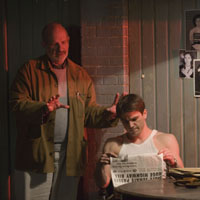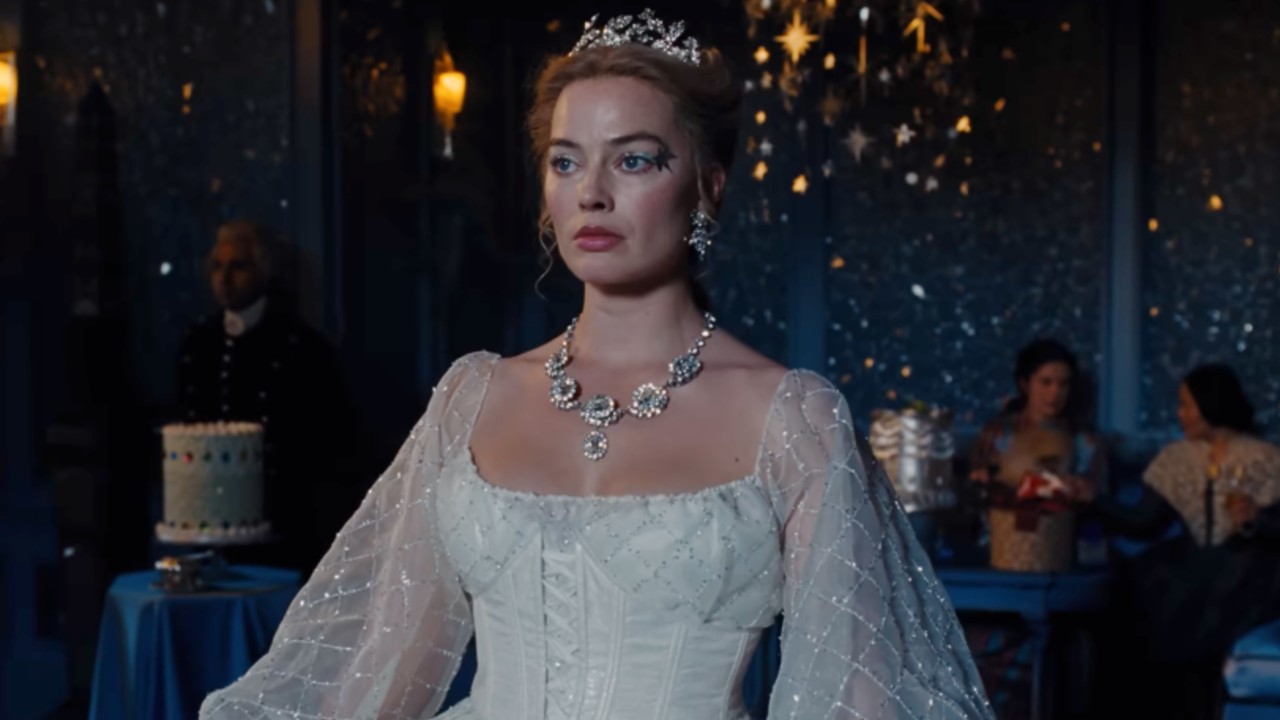Interview: Brian De Palma

Brian De Palma has made legendary crime and noir-ish thrillers, so adapting James Ellroy seems like a perfect fit for him. His film of Ellroy’s The Black Dahlia combines all those elements – seedy gangsters, hard boiled detectives, violent crimes and a macabre sense of humor. He talked about that and more when I caught him out junketing for The Black Dahlia.
“But that's the tone of the book,” said De Palma. “That very much exists in the book. I was just talking to some journalist about this is closer to Sunset Boulevard with the funeral of the monkey and when he arrives at Norma’s estate. It's like, 'Okay, how are we supposed to take that?' I mean, you take Bill Holden’s kind of wry analysis of what he's watching and this is very much true in this piece too because once you’re at the Linscotts, you're in a nut house. These people are insane and the way that Ellroy wrote it is sort of like a comic opera. I don't know how else to explain it, and so what I did in order to get that approach to the audience originally was to shoot the entrance in first person. I said, 'Okay, you want to see these people? Let them look at you. Let Mrs. Linscott just look at you like you're trash.' 'How is a policeman in my living room?' So that was the adjustment that I made. When you have a dog stuffed with the newspaper with his first million dollars and Hilary [Swank] just started tosses it off like the weather, I mean, you go, 'Wow. I'm in a looney bin here and everyone seems to think it's quite normal.' That exactly how I did it. It was very much in the tone of the Ellroy book”
Set in 1940s Hollywood, detectives Bucky Bleichert (Josh Hartnett) and Lee Blanchard (Aaron Eckhart) try to solve the famous unsolved murder of Elizabeth Short. Old time L.A. was actually constructed in Bulgaria. “This was an unusual movie because the financing kept falling through so I had to go to different capitals and find the locations all again. I keep thinking the Linscott Mansion I found in four different countries. So you have to deal with what you actually have and then with your art director you figure out how I can change it to sort of fit into the design of the movie. In this case the key locations changed many times until we finally got enough financing to make the movie in Bulgaria. By then I had gone through a permutation of these different principle locations like the Linscott’s and the circular staircase which I originally found here in Los Angeles and then I found something in the municipal building in Bulgaria that was somewhat similar to my initial idea. What happens is that these ideas they become concrete in photograph and then they go into your brain and you then design a sequence to make it and that becomes the design of the movie. And of course you're collaborating with Dante Ferretti who was a great eye and he'd come up with something that is an original look for the noir piece.”
Short becomes known as The Black Dahlia because of the brutal nature of her murder. In the film, Short comes to life when Buckey discovers audition footage of her. “That was something that wasn't in the book and all he had was The Dahlia in her eight by ten and then this grotesquely carved body. So everyone talks about her in all kinds of not in too positive of ways whether it's her father or The Cleopatra. They all have sort of bad stories about her. So I thought that we had to show the audience her so that they cared about her and so they could get involved with this tragedy the way that Lee and Bucky ultimately did. So there were a bunch of screen tests in an earlier version of the script. So Mia [Kirshner] and I got together and we started with that. I played the director and she played a person auditioning and I would just do what a very destructive director trying – I guess I was Otto Preminger – to destroy the actress before your eyes and Mia played off of it. She's an actress and she's insecure and she wants the job and I'm saying, 'Is that acting? Is that sadness?' She brought it right to the heart of the audience. It was very moving stuff because it's all real. It was just one long take after another and the reason that it seemed so vivid was that it was happening right before your eyes.”
The Black Dahlia went through many directors before finally landing on De Palma, but he had no problem making the project his own. “It all has to do with specific places, your vision. The process of making a movie is that you take what's in your head and then you have to concretely represent it, the things that have to be photographed. So you start with what's available in terms of the places that you can shoot. So immediately you look around and this is something that I used to teach a little bit. When you see a movie and someone just drives up in front of a hotel and gets out and it's not like a very interesting hotel and it doesn't tell you anything about the characters and the story you say, 'Was anyone thinking about this particular selection?' I mean, these days people see movies all the time and I've also gone into movies and said, 'Any idiot can do this.' because it doesn't look like there is any thought that goes into this. I mean, I think about everything that goes up on that screen because I remember movies where I was entranced by the selection of the actors, the costumes, the locations, the historical period, all of those things. And when you see someone that actually looks like [some thought went into it]… take Pride and Prejudice for an instance. There is a subject that has been many times over and suddenly you have some director bring some specific vision to it with a great art director and you go, 'Wow. I've seen 73 Pride and Prejudices. Why does this one seem to jump off of the screen?' It has a lot to do with the selection of those visual elements.”
It also involves selecting actors. De Palma cast British great Fiona Shaw as Mrs. Linscott, who only has two scenes but becomes a pivotal character in Shaw’s hands. “Well, I've known Fiona Shaw and I've watched her work for years. I mean, she is one of the great actresses of our day and you're right to say that no one knows who the hell she is. When she comes into my office in Santa Monica, you know, Fiona Shaw and starts to read, and she wasn't even reading for that part. She was reading for the neighbor and suddenly, we sit in offices and we watch people read lines and you go, 'Okay, that's great.' And you've heard them 173 times and they don't come to life unless they're in the hands of a really fine actor and then suddenly you get a great actress. I mean, one of the great actresses of her day and she suddenly makes this material jump off at you and she can do anything. You can mold her and direct her. This is what I found with Vanessa Redgrave in Mission Impossible. They can do anything and they're very cooperative. They're used to being directed and they just want to see what I can do to make this better and she was a revelation. She's got all that horrendous exposition to deal with. Can you imagine that in the hands of someone else? She manages to do some grotesque comic thing with it that's fascinating. When I was shooting her I was just like this. 'Oh my God, what is she going to do next?' She had to get through that whole flashback and all of that stuff that you had to communicate, that Freddy the Explainer has to communicate to the audience and she does it in some fantastic kind of grand opera way complete with the sort of smile. Of course many people will think, 'Oh my God, it's over the top. How can anyone believe this.' But I thought that it was just marvelous and I think that she's a genius of an actress.”
Ellroy himself didn’t mind De Palma cutting the neighbor character ultimately. “Oh, no, no. Ellroy's attitude is like, 'I got the money. Good luck.' We have to deal with these problems by ourselves. That part was a neighbor who has the clown portrait. Okay, I have this clown portrait that I'm supposed to get in the audiences mind. Now, how the hell am I going to do that because it's in the neighbors house? It's not even in the Linscott house. It was sold later on because the book of course has many things that happen over a period of time. Her husband just killed himself and there is a whole other story with the neighbor that talks about the Linscott children and especially about Madeleine and what a nut case she is. That's a whole other line that I had to sort of deal with. I had actually cast the part. My friend Amy Irving was cast in the part and we were going to do it and then I said, 'Oh my God, we're going to go down to the neighbors and that's where the painting is, and then we're going to explain how it got there.' I said, 'Why don't we just have the painting in the Linscott house? It never got out of the house.' So that's the process of cutting all of that stuff up. It's like combining the assassination of Baxter Fitch with the discovery of The Dahlia body. Those happen one thing after another, days and weeks apart, but I put them together to move the story along because everyone [is like], 'When are we going to get to The Black Dahlia?' In the book it's like page a hundred and thirty. So, again, it was an attempt to try and deal with the back story which is indeed there is a whole bunch more material about Bucky and his dirty dealings and Lee with the bank robbery and all of that stuff. I tried to get that very much compressed in the beginning so that you can get on to the sort of nightmare that is obsessing this trio in the mid part of the story.”
Your Daily Blend of Entertainment News
The Black Dahlia opens Friday.
